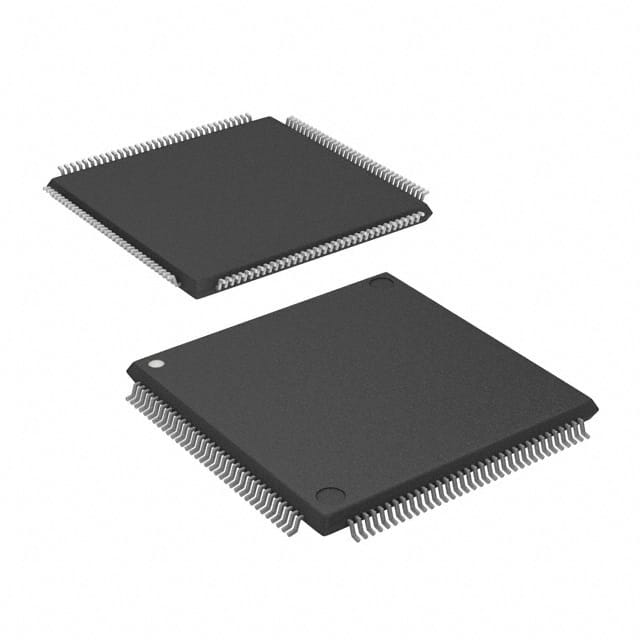PIC32MZ1024EFE144-I/PL
Product Overview
Category: Microcontroller
Use: Embedded systems, Internet of Things (IoT) devices
Characteristics: High-performance, low-power consumption, extensive peripheral integration
Package: 144-pin TQFP
Essence: Advanced microcontroller with integrated peripherals and memory
Packaging/Quantity: Tray packaging, quantity varies
Specifications
- Microcontroller Family: PIC32MZ
- Processor Core: MIPS32® M-Class core
- Clock Speed: Up to 200 MHz
- Flash Memory: 1 MB
- RAM: 512 KB
- Operating Voltage: 2.3V - 3.6V
- I/O Pins: 83
- Communication Interfaces: UART, SPI, I2C, USB, Ethernet
- Analog-to-Digital Converter (ADC): 16-bit, 24 channels
- Digital-to-Analog Converter (DAC): 12-bit, 2 channels
- Timers/Counters: Multiple timers/counters available
- Operating Temperature Range: -40°C to +85°C
Pin Configuration
The PIC32MZ1024EFE144-I/PL microcontroller has a total of 144 pins. The pin configuration is as follows:
- Pins 1-10: Analog input pins
- Pins 11-42: General-purpose I/O pins
- Pins 43-56: Communication interface pins (UART, SPI, I2C)
- Pins 57-64: USB interface pins
- Pins 65-72: Ethernet interface pins
- Pins 73-96: Additional general-purpose I/O pins
- Pins 97-120: Timer/counter pins
- Pins 121-128: Analog output pins
- Pins 129-144: Power supply and ground pins
Functional Features
- High-performance MIPS32® M-Class core for efficient processing
- Extensive peripheral integration for versatile applications
- Advanced communication interfaces for seamless connectivity
- Analog-to-Digital Converter (ADC) for precise analog signal acquisition
- Digital-to-Analog Converter (DAC) for accurate analog output generation
- Multiple timers/counters for event timing and synchronization
Advantages and Disadvantages
Advantages: - High clock speed enables fast processing - Extensive peripheral integration reduces external component count - Wide operating voltage range allows flexibility in power supply - Ample flash memory and RAM for storing and executing complex programs - Versatile communication interfaces facilitate connectivity with other devices
Disadvantages: - Limited number of I/O pins may restrict the number of connected peripherals - Higher power consumption compared to low-power microcontrollers - Relatively larger package size may require more board space
Working Principles
The PIC32MZ1024EFE144-I/PL microcontroller operates based on the MIPS32® M-Class core architecture. It executes instructions stored in its flash memory, processes data, and controls various peripherals and interfaces. The microcontroller communicates with external devices through its communication interfaces such as UART, SPI, I2C, USB, and Ethernet. It can acquire analog signals using its built-in ADC and generate analog outputs using its DAC. The microcontroller's timers/counters enable precise timing and synchronization of events.
Application Field Plans
The PIC32MZ1024EFE144-I/PL microcontroller finds applications in various fields, including: 1. Industrial automation systems 2. Home automation and smart devices 3. Internet of Things (IoT) devices 4. Robotics and control systems 5. Automotive electronics 6. Medical equipment 7. Consumer electronics
Alternative Models
- PIC32MZ1024EFE064-I/PL: Similar to the PIC32MZ1024EFE144-I/PL, but with 64 pins.
- PIC32MZ2048EFE144-I/PL: Higher-end version with 2 MB flash memory and 1 MB RAM.
- PIC32MZ0512EFE064-I/PL: Lower-end version with 512 KB flash memory and 256 KB RAM.
These alternative models provide options with varying pin counts, memory sizes, and performance levels to suit different application requirements.
Word count: 518 words
قم بإدراج 10 أسئلة وإجابات شائعة تتعلق بتطبيق PIC32MZ1024EFE144-I/PL في الحلول التقنية
What is the maximum operating frequency of PIC32MZ1024EFE144-I/PL?
- The maximum operating frequency of PIC32MZ1024EFE144-I/PL is 200 MHz.What are the key features of PIC32MZ1024EFE144-I/PL?
- PIC32MZ1024EFE144-I/PL features a high-performance MIPS M5150 CPU, ample memory, and various peripherals for connectivity and control.Can PIC32MZ1024EFE144-I/PL be used in industrial automation applications?
- Yes, PIC32MZ1024EFE144-I/PL is suitable for industrial automation due to its robust features and performance.Does PIC32MZ1024EFE144-I/PL support Ethernet connectivity?
- Yes, PIC32MZ1024EFE144-I/PL has integrated Ethernet MAC and PHY, making it suitable for networking applications.What development tools are available for PIC32MZ1024EFE144-I/PL?
- Development tools such as MPLAB X IDE and MPLAB Harmony framework support PIC32MZ1024EFE144-I/PL.Is PIC32MZ1024EFE144-I/PL suitable for real-time embedded systems?
- Yes, PIC32MZ1024EFE144-I/PL is well-suited for real-time embedded systems with its high performance and peripheral integration.Can PIC32MZ1024EFE144-I/PL be used in medical device applications?
- Yes, PIC32MZ1024EFE144-I/PL can be utilized in medical devices due to its reliability and performance.What communication interfaces does PIC32MZ1024EFE144-I/PL support?
- PIC32MZ1024EFE144-I/PL supports interfaces such as SPI, I2C, UART, USB, and CAN for versatile connectivity options.Is PIC32MZ1024EFE144-I/PL suitable for power-sensitive applications?
- Yes, PIC32MZ1024EFE144-I/PL offers low-power modes and features, making it suitable for power-sensitive applications.Are there any application notes or reference designs available for PIC32MZ1024EFE144-I/PL?
- Yes, Microchip provides application notes and reference designs to assist in implementing PIC32MZ1024EFE144-I/PL in various technical solutions.


